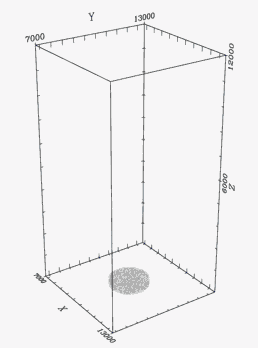Langhans, Yeo, and Romps, Lagrangian investigation of the precipitation efficiency of convective clouds, JAS, 2015
Paper
Description
An animation of an LES of a deep-convective cloud with water-tracking Lagrangian particles. Various colors correspond to different water classes, e.g., gray particles are water vapor, dark blue particles are liquid cloud drops, etc. Click here for an MP4 version of this animation.

The primary responsibility of deep convective clouds is to dry the atmosphere and, thereby, convert latent heat (present in water vapor) to sensible heat (i.e., warmth, which balances the net radiative cooling of the atmosphere). But, along the way, these deep convective clouds regulate the water-vapor content of the atmosphere and the amount of high-altitude cirrus. Both water vapor and cirrus exert a greenhouse effect, and the amount of water vapor and cirrus that a convective cloud pumps into the atmosphere depends on how efficiently a cloud removes water from the atmosphere as precipitation (as opposed to dumping it back into the atmosphere as water vapor or cirrus). This efficiency is measured by a quantity known as the precipitation efficiency: the ratio of precipitation to the total water processed by the cloud.
Here, we study the precipitation efficiency in a high-resolution large-eddy simulation of individual clouds outfitted with a novel type of Lagrangian particles. Unlike previous uses of Lagrangian particles, which are designed to follow representative nitrogen molecules (which are inert and move passively with the flow), these particles are designed to follow representative water molecules. A Monte Carlo approach is used to specify the transitions of a particle from one water class to another in a way that statistically emulates the underlying Eulerian microphysical transitions. With this technique, we are able to follow the history of water through both physical and microphysical space. In particular, we can measure the precipitation efficiency separately for water vapor from different origins, such as from above or below cloud base, as illustrated in the figure below.
Using water-following Lagrangian particles, we can quantify the pathways of water through clouds. In this example, water is broken down into two categories: water originated from above (blue) and below (red) cloud base. Solid lines denote water vapor, dashed lines denote non-precipitating condensates, and dot-dashed lines denote precipitating hydrometeors.
